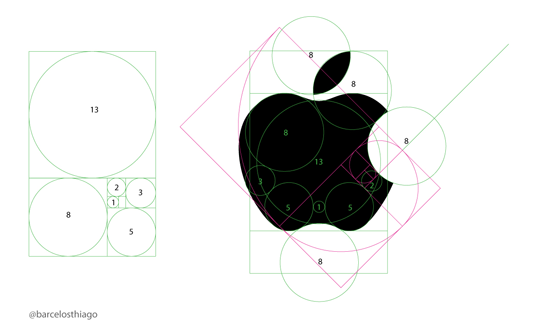The math that every designer needs to know
Leona Henryson investigates what designers may not know about the influence of math on design.
If you ask a designer if he or she considers himself or herself to be particularly talented at math, most likely the answer will be, no. This is because many people who pursue artistic fields believe that the skills required for art and design simply have no relationship to the skills required for mathematical pursuits.
What many of these individuals fail to realize is that math is an integral part of design. In fact, concepts such as patterns, symmetry, positive and negative space, arrangement, and sequence that are so important to design all have a basis in mathematics.
Fractals

Fractals are repeating geometric patterns that combine to form a whole. In nature, fractals make up leaves, snowflakes, geological structures, and ice crystals. You can even slice open an orange to see the repeating shape of the fluid filled pulp. These are also fractals.

Human cells when examined under a microscope are also made of tiny repeating fractals. Scientists can use computers and mathematical formulas to create models of nearly anything based on fractals. All they need to know is the shape of the fractal at the smallest level and then get that fractal to multiply.

Designers use fractals in everything from clothing design to website backgrounds. Zigzags and paisley are two examples of the ways in which fractals can make their way into design. Here is an example of fractals used for design purposes.
Fibonacci sequence

Let's play a quick game. Take a look at the following sequence of numbers and try to determine which number comes next. 0, 1, 1, 2, 3, 5, 8, 13, 21, 34, 55...
If you guessed 89, you are absolutely correct. The pattern in these numbers is a Fibonacci sequence. Take a look at the numbers again. Each number after the sixteen is the sum of the two numbers prior to that. To begin a Fibonacci sequence, you just need to 'seed' the sequence with a starter number and then double that number to start the pattern.
Daily design news, reviews, how-tos and more, as picked by the editors.

You're probably wondering at this point what any of this has to do with art. When these numbers are translated into shapes various patterns emerge including spirals, flowering, and branching. These shapes can be seen in nature and in art.
This is because once the Fibonacci sequence was discovered, these numbers were divided back to as close to zero as they could in order to form the golden ratio which is the basis of the following shape which is the template for the perfect spiral.

Spirals, as you know appear quite frequently in design. Arranged in other ways, Fibonacci numbers form the basis of stars and many other geometric shapes. Even the human face closely follows this pattern.

Historical architecture such as the pyramids and the Parthenon also contain the Fibonacci sequence if you examine them closely. To learn more about the ways in which this pattern of numbers has influenced art, do some research on the work of Da Vinci. He is very well known for his incorporation of the golden ratio into his work.
Words: Leona Henryson
Main image: Phil Webster/Mathematical Art Galleries
Leona Henryson is involved in a number of freelance endeavors – website and graphic design, communication design, interior design, fashion and styling, kids’ fashion, contributor at trustmypaper, and much more. Follow her on Twitter and Facebook.
Like this? Try these…
- Tips for using grids in logo design
- The biggest logo designs of 2015 so far
- The best tools for data visualization

The Creative Bloq team is made up of a group of art and design enthusiasts, and has changed and evolved since Creative Bloq began back in 2012. The current website team consists of eight full-time members of staff: Editor Georgia Coggan, Deputy Editor Rosie Hilder, Ecommerce Editor Beren Neale, Senior News Editor Daniel Piper, Editor, Digital Art and 3D Ian Dean, Tech Reviews Editor Erlingur Einarsson, Ecommerce Writer Beth Nicholls and Staff Writer Natalie Fear, as well as a roster of freelancers from around the world. The ImagineFX magazine team also pitch in, ensuring that content from leading digital art publication ImagineFX is represented on Creative Bloq.
